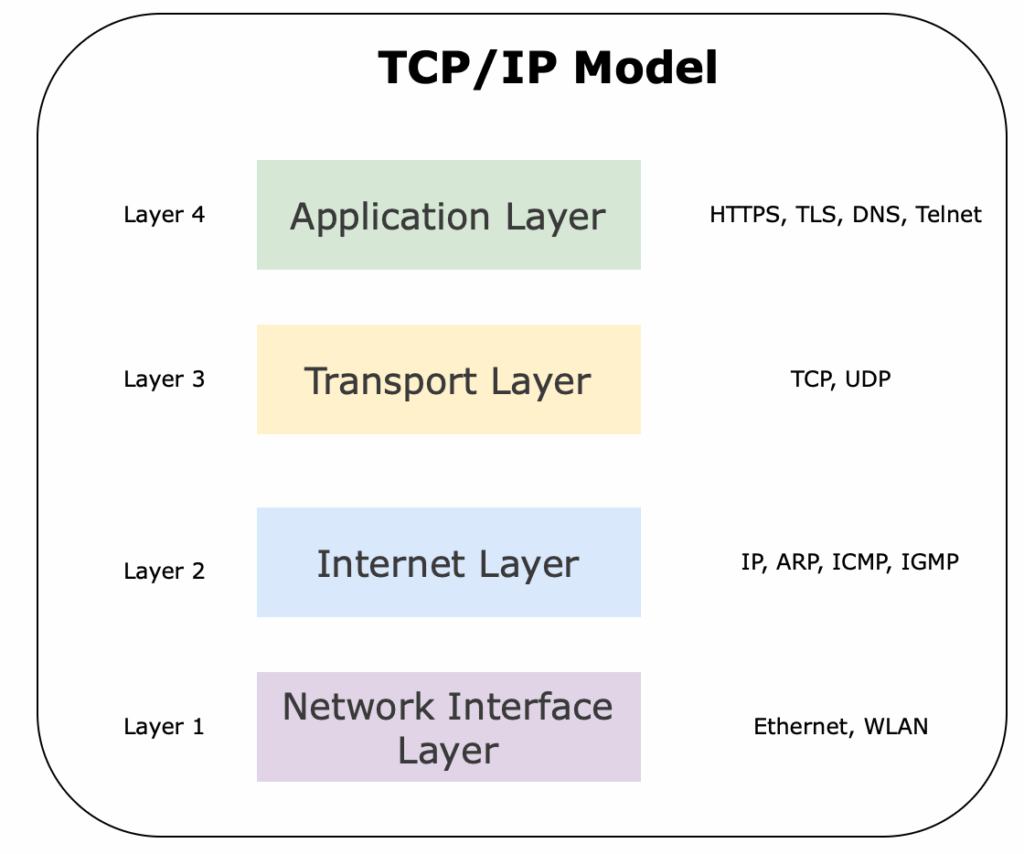In the world of computer networking, the TCP/IP (Transmission Control Protocol/Internet Protocol) model is a fundamental framework for data transmission and communication across the internet. It is the backbone of modern network communication, enabling seamless connectivity and interoperability between diverse systems.
In this comprehensive guide, we will explore the TCP/IP model, understanding its structure, components, and its significance in facilitating efficient data exchange in the digital age.
Table of Contents
What is the TCP/IP Model?
The TCP/IP model is a conceptual framework that defines the protocols and standards used for transmitting data over networks. It consists of four interconnected layers, each responsible for specific functions related to network communication. The TCP/IP model is named after its two key protocols: TCP, which ensures reliable data delivery, and IP, which handles the routing and addressing of data packets.
The Layers of the TCP/IP Model

- Application Layer: The Application layer is responsible for providing network services directly to end-users. It encompasses protocols such as HTTP (Hypertext Transfer Protocol), FTP (File Transfer Protocol), and SMTP (Simple Mail Transfer Protocol). This layer enables applications to exchange data over networks.
- Transport Layer: The Transport layer ensures reliable delivery of data between network hosts. It includes protocols like TCP and UDP (User Datagram Protocol). TCP provides connection-oriented, error-checked, and orderly data transmission, while UDP offers connectionless and faster transmission without error-checking.
- Internet Layer: The Internet layer, primarily governed by the IP protocol, handles the addressing and routing of data packets across different networks. It assigns unique IP addresses to devices, breaks data into packets, and determines the most efficient path for packet delivery.
- Network Interface Layer: The Network Interface layer, also known as the Link layer or Network Access layer, deals with the physical transmission of data over the network medium. It includes protocols specific to the network technology being used, such as Ethernet or Wi-Fi.
Significance of the TCP/IP Model
The TCP/IP model holds several key advantages and significance in network communication:
- Universal Adoption: The TCP/IP model is the foundation of internet communication and is universally adopted across the globe. It enables devices from different vendors and platforms to communicate seamlessly, facilitating the interconnectedness of the digital world.
- Scalability and Flexibility: The TCP/IP model’s modular design allows for easy integration of new technologies and protocols. It can adapt to evolving networking requirements, making it scalable and flexible for future advancements.
- Interoperability: The TCP/IP model ensures interoperability between different systems and networks, allowing seamless communication across diverse devices and platforms. It facilitates the exchange of data between different protocols and technologies.
- Internet Standardization: The TCP/IP model serves as a standard for internet communication, guiding the development and implementation of networking protocols and technologies. It provides a common framework that enables compatibility and uniformity across networks.
Real-World Applications
The TCP/IP model finds extensive practical applications in various networking technologies:
- Web Browsing: The HTTP protocol used for web browsing operates at the Application layer of the TCP/IP model. It allows web browsers and servers to exchange data, enabling users to access and view web pages.
- Email Communication: Protocols like SMTP (Simple Mail Transfer Protocol) and POP (Post Office Protocol) operate at the Application layer, facilitating email communication over networks.
- Network Routing: IP (Internet Protocol) at the Internet layer enables routers to determine the best path for data packets to reach their destination across interconnected networks.
Conclusion
The TCP/IP model serves as a critical framework for network communication, enabling seamless connectivity and data exchange in the digital era. By understanding its layered structure and components, network administrators and professionals gain insights into the complexities of internet communication. The TCP/IP model’s universal adoption, scalability, and interoperability make it an indispensable foundation for networking technologies, shaping the landscape of modern connectivity and driving the growth of the digital world.
FAQ: TCP/IP Model
What is the main purpose of the TCP/IP model?
The TCP/IP model provides a standardized framework for how data is transmitted over networks, ensuring interoperability between devices and enabling reliable internet communication.
How many layers are in the TCP/IP model, and what are they?
The TCP/IP model has four layers: Application, Transport, Internet, and Network Interface (or Link) layer. Each layer has specific roles in managing data communication.
What is the difference between TCP and IP in the model?
TCP (Transmission Control Protocol) ensures reliable and ordered data delivery, while IP (Internet Protocol) handles addressing and routing of data packets across networks.
Why is the TCP/IP model widely used?
It is universally adopted because of its flexibility, scalability, and ability to support diverse systems and technologies, making it ideal for global internet communication.
How does the TCP/IP model support web browsing and email?
Web browsing uses HTTP over the Application layer, while email uses protocols like SMTP and POP at the same layer. These protocols allow data exchange between applications.
Is the TCP/IP model the same as the OSI model?
No, they are different. The OSI model has seven layers, while the TCP/IP model has four. However, they share similar concepts and are often compared for learning purposes.
Can the TCP/IP model be used in private networks?
Yes, the TCP/IP model works in both public and private networks, making it suitable for enterprise intranets, LANs, and global internet communication.
What is the role of the Internet layer in the TCP/IP model?
The Internet layer manages IP addressing and routing, ensuring data packets reach the correct destination through different interconnected networks.